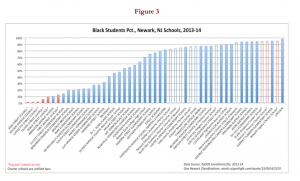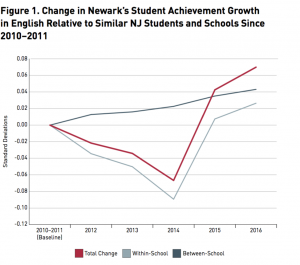Mark Weber (2015) finds reason to believe that the policies associated with One Newark are potentially destructive to the Newark Public Schools and lead to practices of segregation and racial biases. This website looks at the effects of school closures and segregation practices on Newark schools and Weber (2015) gives a better picture of how school choice in Newark has a negative impact on societal and cultural issues.
Chin et al (2017) see educational reform in Newark from a different perspective. When comparing Newark district schools with charter schools, they find a net achievement gain from the educational reforms installed under superintendent Cami Anderson after a private philanthropy donation of $200 million from Mark Zuckerberg. Chin et al (2017) find that shifting enrollment from lower to higher achievement growth schools was responsible gains in English and better than expected gains in math.
These two articles offer different voices to the effectiveness of school choice and charter school gains in Newark. Nearly a third of Newark students now attend charter schools and it is important to understand their impact, given the direct correlation to school closures and loss of revenue for Newark district schools. Chin et al (2017) state, “the strategy of closing or repurposing the least effective schools, opening new district and charter schools, and giving families greater choice produced gains in English and offset what would have been a relative decline in achievement growth in math” (p. 7).

Chart showing the number of black students in these “great” schools. Schools all the way to the right represent Charters with significant black student populations. Source: Weber (2015)
Weber (2015) contests the idea of achievement growth as a good thing, as greater school choice in Newark is creating cultural issues that counteract this growth. He raises many concerns, chief among them being the fact that a school rating as part of the One Newark plan has less to do with school effectiveness than it does with student demographics. (Weber, 2017, p.1). According to Weber, schools that are labeled as “great” have a less diverse student body in term of race, socioeconomic status, disability, and gender. These effects of school policy go beyond simple test scores and student achievement, but effect entire communities. If One Newark is a catalyst in segregating schools within Newark, then does this offset the gains found by Chin et al (2017)?

Figure shows the improvement in English and Language Arts scores since 2010 in all Newark Schools (Total Change in red). Source: Chin et al (2017)
The difference in these two articles are at the center of the debate over school policy in Newark. If charter schools are indeed effective in producing gains in educational attainment, is it still a problem that they take away funding from NPS schools. It is important for both educational sectors to flourish and to find the correct balance in this problem.
Despite their difference, Chin et al (2017) and Weber (2015) find a common denominator in the fact that more research must be done in order to make more decisive conclusions. Weber (2015) discusses the uniqueness of One Newark, as it is the first universal enrollment system in New Jersey (p.10). Chin et al (2017) admits that Newark had an unusual set of effective charter school already in place when reforms began and that other cities must be wary of these factors before choosing any similar system (p. 7).
